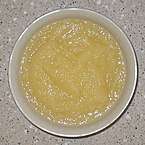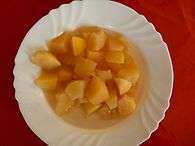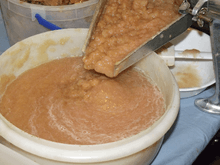Apple sauce
Apple sauce or applesauce is a sauce made of apples. It can be made with peeled or unpeeled apples and may be spiced or sweetened. Apple sauce is inexpensive and widely used in North America and some of Europe.[1]


A wide range of apple varieties is used to make apple sauce, depending on the preference for sweetness or tartness.[2][3] Formerly, sour apples were used to make savory apple sauce.[4]
Commercial versions of apple sauce are readily available at retail grocers.
Preparation

Apple sauce is made by cooking down apples with water or apple cider (fresh apple juice). More acidic apples will render a finer purée; the highly acidic Bramley apple creates a very fine purée. The apples may or may not be peeled; if they are not peeled, the peels and seeds are typically separated in a food mill.[5] Sugar, and spices such as cinnamon and allspice may be added for flavoring. Lemon juice, citric acid, or other acidifiers may be used to preserve the color and ensure a enough acidity for safe storage. Ascorbic acid (vitamin C) also preserves the color.
A baked apple sauce can be made by baking rather than boiling, in which case the apples are peeled and cored before cooking.[6]
Home or commercially canned apple sauce is sterilized by heat to preserve freshness.[7]
Apple butter
Apple butter is a highly concentrated version of apple sauce. Its high concentration of sugar gives it a long shelf life.[8]
Uses
Apple sauce is served as a side dish in northern Europe and north America.
In Sweden and Britain, it is commonly served with roast pork and goose. In British and Spanish cuisine, it is commonly served as pork chops and apple sauce. The Danish æbleflæsk combines the pork with apple sauce while cooking it.
In Central Europe, it accompanies potato pancakes, in particular, in the Rhineland, it is served with Reibekuchen, and in Ashkenazi cuisine, it is the standard accompaniment for Hanukkah latkes; it also accompanies matzah brei. Apple sauce is served with many foods in Germanic cuisine: flurgönder, a smoked meat; various kinds of spätzle, including Schupfnudeln; SwissÄlplermagronen, a kind of macaroni and cheese. In Netherlands and Belgian cuisine, apple sauce is part of the common dish of chicken, french fries, and apple sauce (kip, frieten/patat en appelmoes); it is especially popular among children, who dip their fries in mayonnaise first, then apple sauce.[9]
In many cuisines, apple sauce is a common accompaniment to blood sausage: the German Himmel und Erde; the Luxembourg träipen; and the French boudin noir. In fact, in France, the only savory dish normally served with apple sauce (compote de pommes) is boudin sausage, both white and black. It is also served with other sausage-like preparations, like goetta and knipp.
Apple sauce may also be served as a dessert in most European cuisines, or used as an ingredient in applesauce cake.[10] Apple sauce may be used as a sauce for Polish pierogis, Swedish Äggakaka, Ukrainian syrniki pancakes, Central European Palatschinken, German Kaiserschmarrn, and various kinds of sweet and savory dumplings (Knödel). In Scandinavian cuisine, it sometimes served with breakfast filmjölk, a kind of fermented milk.
Formerly, heavily sweetened and boiled-down apple sauce was prepared for winter storage. Made with sour apples, it was eaten with meat; made with sweet apples, it was eaten with tea.[4]
In some recipes for baked goods, apple sauce can be used as a substitute for fat[11][12][13] or eggs to make them low-fat or vegan.[14][15][16][17] Bavarian sweet mustard may be made with applesauce, and is typically served with Weißwurst (similar to boudin blanc) or Leberkäse (a sort of pâté).
In special diets
Apple sauce is an "old-fashioned diarrhea remedy".[18] The older BRAT diet and the more effective CRAM diet include apple sauce, and are given to children with diarrhea and stomach problems.[19][20]
Apple sauce is a common component of a soft diet.
Origins
Sauces made with apples date to at least the Middle Ages.[21]
See also
- Mott's, a major U.S. producer
- Seneca Foods, a major U.S. producer
- C.H. Musselman's, a brand owned by Knouse Foods
- Prigat, a major Israeli producer
- Three Threes Condiments, an Australian producer
References
| Look up apple sauce in Wiktionary, the free dictionary. |
| Wikimedia Commons has media related to Apple sauce. |
- Palmatier, Robert Allen (2000). Food: a dictionary of literal and nonliteral terms. Greenwood. p. 11. ISBN 978-0-313-31436-0.
- Erin Huffstetler, "The 11 Best Apples for Applesauce", The Spruce Eats 10/02/2019
- "Recommended Uses of Apple Varieties", in Tim Burford, Apples of North America: Exceptional Varieties for Gardeners, Growers, and Cooks, 2013, ISBN 1604692499, p. 278
- Hale, Sarah Josepha Buell (1839). The good housekeeper: or, The way to live well and to be well while we live : containing directions for choosing and preparing food, in regard to health, economy and taste. Weeks, Jordan. p. 79. Retrieved 11 January 2011.
- Mark Bittman, How to Cook Everything: Simple Recipes for Great Food, 20th anniversary edition, 2019, ISBN 1328545679, p. 364
- Eliza Acton, Modern Cookery, for Private Families, 1860, p. 124
- "Applesauce". NY Apple Association. Retrieved 2020-03-23.
- Rosenstein, Mark (1999). In Praise of Apples: A Harvest of History, Horticulture & Recipes. Lark Books. p. 135. ISBN 978-1-57990-124-0. Retrieved 11 January 2011.
- "The Dutch Table"
- "Applesauce Cake, Source: U.S. Department of Defence". Theodora's Recipies [sic]. Retrieved 1 March 2014.
- David Tao (13 November 2012). "Healthier Ways to Bake Without Butter or Oil". Greatist. Retrieved 1 October 2014.
- "Baking Alternatives - Reducing Fat in Your Favorite Baked Goods Recipes". Wilton Blog - Ideas from Wilton. Archived from the original on 4 November 2015. Retrieved 1 October 2014.
- "HowStuffWorks "Ultimate Guide to Low-fat Baking"". HowStuffWorks. Retrieved 1 October 2014.
- Julie R. Thomson (11 August 2015) [6 August 2015]. "5 Ingredients To Substitute For Eggs In Vegan Baking". Huffington Post.
- David Tao (13 November 2012). "Healthier Ways to Bake Without Butter or Oil". Greatist. Retrieved 1 October 2014.
- "Baking Alternatives - Reducing Fat in Your Favorite Baked Goods Recipes". Wilton Blog - Ideas from Wilton. Archived from the original on 4 November 2015. Retrieved 1 October 2014.
- "HowStuffWorks "Ultimate Guide to Low-fat Baking"". HowStuffWorks. Retrieved 1 October 2014.
- Graedon, Joe; Teresa Graedon (2002). The People's Pharmacy Guide to Home and Herbal Remedies. Macmillan. p. 198. ISBN 978-0-312-98139-6. Retrieved 11 January 2011.
- Mackell, S (1 December 2005). "Traveler's diarrhea in the pediatric population: etiology and impact". Clinical Infectious Diseases. 41 Suppl 8: S547-52. doi:10.1086/432950. PMID 16267717.
- King CK, Glass R, Bresee JS, Duggan C (November 2003). "Managing acute gastroenteritis among children: oral rehydration, maintenance, and nutritional therapy". MMWR Recomm Rep. 52 (RR-16): 1–16. PMID 14627948.
- https://www.erinnudi.com/2014/09/05/food-history-applesauce/
